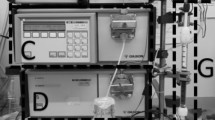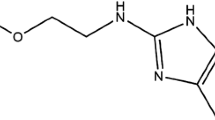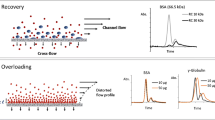Abstract
Adsorption of human serum albumin (HSA) and immunoglobulin G (IgG), two most relevant proteins in blood serum were measured separately on a new mixed-mode adsorbent (MabDirect MM), especially designed for expanded bed adsorption process. Expanded bed behavior characterization by residence time distribution experiments for different columns (Streamline 50 for HSA study, Omnifit 66/20 and XK 16/20 for IgG study) are presented together with breakthrough adsorption of HSA and IgG for different conditions and compared with simulation results by a mathematical model. Regarding HSA adsorption, all four experiments were conducted at the same buffer solution (pH 5.0 without salt), and it was obtained a dynamic binding capacity of 8.9, 9.7, 7.5 and 7.0 mg·gdry−1 (24.8, 27.0, 21.0 and 19.5 mg·cm−3) at 10% of breakthrough, corresponding to a 41, 39, 38 and 30% of the saturation capacity for runs 1–4, respectively. The results from the simulation of the mathematical model fitted well with the breakthrough experiments. Elution stage was optimized by lowering flow rate and changing the buffer solution pH and NaCl concentration. Concerning IgG adsorption, for IgG feed concentration of 0.53 g·dm−3 in 20 mM citrate buffer, pH 5.0 with 0.4 M NaCl, at 2.2 cm3·min−1, it was obtained a DBC of 3.3 mg·gdry−1 (9.1 mg·cm−3) at 10% of breakthrough, representing 22% of the saturation capacity. While for a feed concentration of 0.11 g·dm−3 of IgG in the same buffer solution, at 6 cm3·min−1, it was obtained a DBC of 2.7 mg·gdry−1 (7.4 mg·cm−3) at 10% of breakthrough, representing 34% of the saturation capacity.














Similar content being viewed by others
References
Antibody Production and Purification Technical Handbook. Thermo Scientific, Waltham (2010)
Arévalo, E., Rendueles, M., Fernández, A., Díaz, M.: Equilibrium and simulation of the operation for the adsorption of albumin proteins in an iminodiacetic-Cu bounded ion exchange resin (IMAC). Sep. Purif. Technol. 18, 217–225 (2000)
Bruce, L.J., Chase, H.A.: Hydrodynamics and adsorption behaviour within an expanded bed adsorption column studied using in-bed sampling. Chem. Eng. Sci. 56, 3149–3162 (2001)
Carson, K.L.: Flexibility—the guiding principle for antibody manufacturing. Nat Biotechnol. 23, 1054–1058 (2005)
Chase, H.A., Draeger, N.M.: Affinity purification of proteins using expanded beds. J. Chromatogr. A 597, 129–145 (1992)
de Andrade Lima, M., de Freitas, M.D., Gonçalves, L.R., da Silva Junior, I.J.: Recovery and purification of a Kluyvermyces lactis β-galactosidase by mixed mode chromatography. J. Chromatogr. B 1015–1016, 181–191 (2016)
Du, Q.Y., Lin, D.Q., Zhang, Q.L., Yao, S.J.: An integrated expanded bed adsorption process for lactoferrin and immunoglobulin G purification from crude sweet whey. J Chromatogr B 947–948, 201–207 (2014)
Fan, L.-T., Yang, Y.-C., Wen, C.-Y.: Mass transfer in semifluidized beds for solid-liquid system. AIChE J. 6, 482–487 (1960)
Fanali, G., di Masi, A., Trezza, V., Marino, M., Fasano, M., Ascenzi, P.: Human serum albumin: from bench to bedside molecular. Asp. Med. 33, 209–290 (2012)
Feuser, J., Halfar, M., Lutkemeyer, D., Ameskamp, N., Kula, M., Thommes, J.: Interaction of mammalian cell culture broth with adsorbents in expanded bed adsorption of monoclonal antibodies. Process Biochem. 34, 159–165 (1999)
Gomes, P.F., Loureiro, J.M., Rodrigues, A.E.: Adsorption equilibrium and kinetics of Immunoglobulin G on a mixed-mode adsorbent in batch and packed bed configuration. J. Chromatogr. A 1524, 143–152 (2017a)
Gomes, P.F., Loureiro, J.M., Rodrigues, A.E.: Adsorption of Human Serum Albumin (HSA) on a mixed-mode adsorbent: equilibrium and kinetics Adsorption 23, 491–505 (2017b)
Hashim, M.A., Chu, K.H., Tsan, P.S.: Modelling of protein adsorption in a fixed-bed: Singule and Two-soute breakthrough behaviour. Chem. Eng. Commun. 161, 45–63 (1997)
Hoffman, W.L., O’Shannessy, D.J.: Site-specific immobilization of antibodies by their oligosaccharide moieties to new hydrazide derivatized solid supports. J. Immunol. Methods 112, 113–120 (1988)
Kelly, W., et al.: Experimental characterization of next-generation expanded-bed adsorbents for capture of a recombinant protein expressed in high-cell-density yeast fermentation. Biotechnol. Appl. Biochem. 60, 510–520 (2013a)
Kelly, W., Kamguia, G., Mullen, P., Ubiera, A., Göklen, K., Huang, Z., Jones, G.: Using a two species competitive binding model to predict expanded bed breakthrough of a recombinant protein expressed in a high cell density fermentation. Biotechnol. Bioprocess Eng. 18, 546–559 (2013b)
Li, P.: Protein separation and purification by expanded bed chromatography and simulated moving bed technology. Faculty of Engineering University of Porto (2006)
Li, P., Xiu, G., Rodrigues, A.E.: Modeling separation of proteins by inert core adsorbent in a batch adsorber. Chem. Eng. Sci. 58, 3361–3371 (2003)
Li, P., Xiu, G., Rodrigues, A.E.: Experimental and modeling study of protein adsorption in expanded bed. Am. Inst. Chem. Eng. J. 51, 2965–2977 (2005)
Li, P., Gomes, P.F., Loureiro, J.M., Rodrigues, A.E.: Proteins separation and purification by expanded bed adsorption and simulated moving bed technology. In: Subramanian, G. (ed.) Continuous Processing in Pharmaceutical Manufacturing. Wiley, Weinheim (2014)
Malm, B.: A method suitable for the isolation of monoclonal antibodies from large volumes of serum-containing hybridoma cell culture supernatants. J. Immunol. Methods. 104, 103–109 (1987)
Martin, C., Iberer, G., Ubiera, A., Carta, G.: Two-component protein adsorption kinetics in porous ion exchange media. J. Chromatogr. A 1079, 105–115 (2005)
Palsson, E., Axelsson, A., Larsson, P.O.: Theories of chromatographic efficiency applied to expanded beds. J. Chromatogr. A 912, 235–248 (2001)
Ranjini, S.S., Bimal, D., Dhivya, A.P., Vijayalakshmi, M.A.: Study of the mechanism of interaction of antibody (IgG) on two mixed mode sorbents. J. Chromatogr. B 878, 1031–1037 (2010)
Ranz, W., Marshall, W.: Evaporation from drops. Chem. Eng. Prog. 48, 141–146 (1952)
Rendueles de la Vega M., Chenou, C., Loureiro, J.M., Rodrigues, A.E.: Mass transfer mechanisms in Hyper D media for chromatographic protein separation. Biochem. Eng. J. 1, 11–23 (1998)
Rezvani, A., Jahanshahi, M., Najafpour, G.D.: Characterization and evaluation of the novel agarose–nickel composite matrix for possible use in expanded bed adsorption of bio-products. J. Chromatogr. A 1331, 61–68 (2014)
Schaller, J., Gerber, S., Kaempfer, U., Lejon, S., Trachsel, C.: Human Blood Plasma Proteins: Structure and Function. Wiley, Chichester (2008)
Shi, W., Lin, D.-Q., Tong, H.-F., Yun, J.-X., Yao, S.-J.: 5-Aminobenzimidazole as new hydrophobic charge-induction ligand for expanded bed adsorption of bovine IgG. J. Chromatogr. A 1425, 97–105 (2015)
Skidmore, G.L., Chase, H.A.: Two-component protein adsorption to the cation exchanger S Sepharose® FF. J. Chromatogr. A 505, 329–347 (1990)
Thommes, J., Halfar, M., Lenz, S., Kula, M.R.: Purification of monoclonal antibodies from whole hybridoma fermentation broth by fluidized bed adsorption. Biotechnol. Bioeng. 45, 205–211 (1995)
Thommes, J., Bader, A., Halfar, M., Karau, A., Kula, M.R.: Isolation of monoclonal antibodies from cell containing hybridoma broth using a protein A coated adsorbent in expanded beds. J. Chromatogr. A 752, 111–122 (1996)
Van Der Meer, A.P., Blanchard, C.M.R.J.P., Wesselingh, J.A.: Mixing of particles in liquid fluidized beds. Chem. Eng. Res. Des. 62, 214–222 (1984)
Wakao, N., Funazkri, T.: Effect of fluid dispersion coefficients on particle-to-fluid mass transfer coefficients in packed beds: correlation of sherwood numbers. Chem. Eng. Sci. 33, 1375–1384 (1978)
Walters, R.R., Graham, J.F., Moore, R.M., Anderson, D.J.: Protein diffusion coefficient measurements by laminar flow analysis: method and applications. Anal. Biochem. 140, 190–195 (1984)
Weinbrenner, W.F., Etzel, M.R.: Competitive adsorption of alpha-lactalbumin and bovine serum albumin to a sulfopropyl ion-exchange membrane. J. Chromatogr. A 662, 414–419 (1994)
Wilson, E.J., Geankoplis, C.J.: Liquid mass transfer at very low reynolds numbers in packed beds. Ind. Eng. Chem. Fundam. 5, 9–14 (1966)
Wright, P.R., Glasser, B.J.: Modeling mass transfer and hydrodynamics in fluidized-bed adsorption of proteins. Am. Inst. Chem. Eng. J. 47, 474–488 (2001)
Xia, H.F., Lin, D.Q., Yao, S.J.: Chromatographic performance of macroporous cellulose-tungsten carbide composite beads as anion-exchanger for expanded bed adsorption at high fluid velocity. J. Chromatogr. A 1195, 60–66 (2008)
Zhao, J., Yao, S., Lin, D.: Adsorbents for expanded bed adsorption: preparation and functionalization Chinese. J. Chem. Eng. 17, 678–687 (2009)
Acknowledgements
The authors would like to thank Upfront Chromatography A/S for kindly providing the adsorbent. This work is a result of project “AIProcMat@N2020—Advanced Industrial Processes and Materials for a Sustainable Northern Region of Portugal 2020”, with the reference NORTE-01-0145-FEDER-000006, supported by Norte Portugal Regional Operational Programme (NORTE 2020), under the Portugal 2020 Partnership Agreement, through the European Regional Development Fund (ERDF) and of Project POCI-01-0145-FEDER-006984—Associate Laboratory LSRE-LCM funded by ERDF through COMPETE2020—Programa Operacional Competitividade e Internacionalização (POCI)—and by national funds through FCT—Fundação para a Ciência e a Tecnologia.
Author information
Authors and Affiliations
Corresponding author
Electronic supplementary material
Below is the link to the electronic supplementary material.
Rights and permissions
About this article
Cite this article
Gomes, P.F., Loureiro, J.M. & Rodrigues, A.E. Expanded bed adsorption of albumin and immunoglobulin G from human serum onto a cation exchanger mixed mode adsorbent. Adsorption 24, 293–307 (2018). https://doi.org/10.1007/s10450-018-9940-7
Received:
Revised:
Accepted:
Published:
Issue Date:
DOI: https://doi.org/10.1007/s10450-018-9940-7




